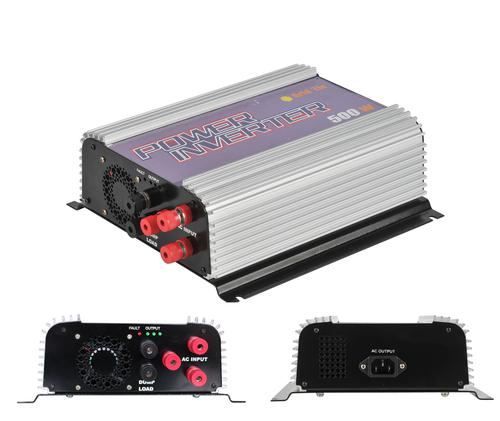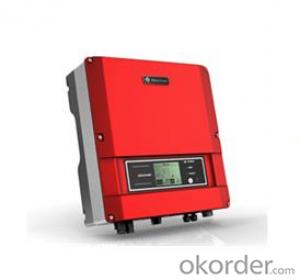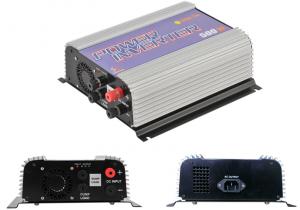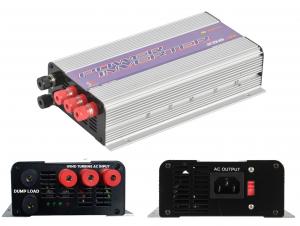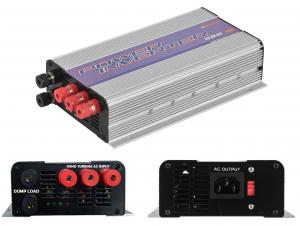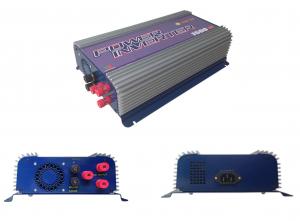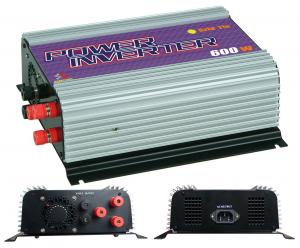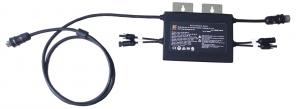SUN-500G-WAL Wind power grid tie inverter/500w
- Loading Port:
- Ningbo
- Payment Terms:
- TT OR LC
- Min Order Qty:
- -
- Supply Capability:
- 1000 kg/month
OKorder Service Pledge
OKorder Financial Service
You Might Also Like
Grid Tie Inverter for Wind Turbine
Model: SUN-500G_WAL
l Build In Rectifier
l Build In Dump Load Controller
l Build In High Wind Protection
Preface
The grid-tie inverter can transfer wind energy from wind generators directly into the home grid using no extra equipment. It can be connected to any outlet (conventional network) in the home. The grid-tie inverter controls the phase and the frequency and voltage of the power generated by the wind generator. It produces a pure sine-wave and matches that of the grid.
This model grid-tie has build in bridge rectifier and dump load controller, it can maintain the rotating speed of the wind turbine and keep the voltage from the wind turbine always at the range of the rated range of the grid tie inverter. It also has a high voltage protection function, when the wind is too big, and the dump load controlling system can’t keep the output voltage from the wind turbine, the controller will disconnect itself from the wind turbine, so it is very safe to be used.
There are 5 terminals on the left side of the inverter, 3 red terminals will be connected to the three phase output from the wind turbine, and 2 black terminals will be connected to dump load resistors.
There are 4 LED indicators, 3 green indicators and 1 red indicator, 3 green LED indicators will start to cycle from left to right when the grid and AC input supply is detected. This indicates the inverter is operating under normal condition. The rate of the cycling is according to how much power is being output from the wind turbine. The bigger the output power is, the faster the rate is. If there is no AC grid detected, the red LED will be on, the inverter will not put out power, this is called “Island Protection”.
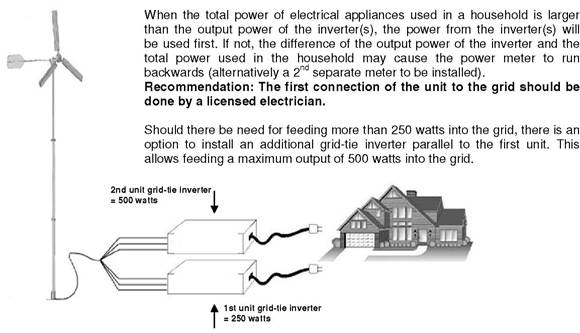
Electrical Specifications:
Model | SUN-500G_WAL | |
Normal AC Output Power | 450W | |
Maximum AC Output Power | 500W | |
AC Output Voltage Range | 110V/230V | 90V ~ 130V / 190V~260V |
AC Output Frequency Range | 46Hz ~ 65Hz | |
Total Harmonic Distortion(THD) | <5% | |
Power Factor | 0.99 | |
DC Input Voltage Range (the test point is at the output of the rectifier) | 22V~60V/10.8-30V | |
Peak Inverter Efficiency | 92% | |
Standby Power consumption | <1.5W | |
Output Current Waveform | Pure Sine-wave | |
MPPT Function | Yes | |
Over Current Protection | Yes | |
Over Temperature Protection | Yes | |
Reverse Polarity Protection | Yes | |
Island Protection | Yes | |
Stackable | Yes | |
| | | |
Mechanical Specifications:
N.W | 4.0kg |
G.W | 4.5Kg |
Dimension | 332mm*265mm*135mm |
Operating Temperature Range
-10 ~ 45 degrees C
- Q: Are there any noise emissions from a solar inverter?
- Yes, solar inverters do produce some noise emissions, although the level of noise is generally very low. The noise is primarily generated by the cooling fans and internal components, but it is usually not significant enough to cause any major disturbances.
- Q: How do you connect a solar inverter to solar panels?
- To connect a solar inverter to solar panels, you need to follow a few steps. First, ensure that the solar panels are properly installed and positioned to receive maximum sunlight. Then, connect the positive and negative terminals of the solar panels to the corresponding terminals on the solar inverter. Make sure to use appropriate cables and connectors for a secure connection. Once the connections are made, the solar inverter will convert the solar energy generated by the panels into usable electricity for your home or business.
- Q: Can a solar inverter be used in three-phase systems?
- Yes, a solar inverter can be used in three-phase systems. Three-phase systems are commonly used in industrial and commercial applications, and solar inverters are available in both single-phase and three-phase configurations to accommodate these systems. The three-phase solar inverter converts the direct current (DC) generated by the solar panels into alternating current (AC) that is compatible with the three-phase power grid.
- Q: Are there any fire safety concerns associated with solar inverters?
- Solar inverters do pose some fire safety concerns. Although they are not typically a fire hazard themselves, there are a few potential risks to be aware of. Firstly, if the solar inverter is installed incorrectly, it can cause electrical problems that may lead to a fire. To prevent this, it is essential to hire a qualified and certified professional who can ensure that all electrical connections are secure and meet the necessary standards. Secondly, if the solar inverter is located in an area that experiences high temperatures or excessive heat, there is a risk of overheating. Inverters generate heat as they convert direct current (DC) from solar panels into alternating current (AC) for use in homes or businesses. If the inverter is not adequately ventilated or is exposed to extreme heat, it can overheat and potentially ignite a fire. Furthermore, if the inverter is faulty or damaged, it can increase the risk of fire. Regular maintenance and inspections of the solar inverter can help identify any potential issues and ensure its safe operation. To address these fire safety concerns, it is crucial to adhere to proper installation guidelines, regularly inspect and maintain the inverter, and ensure it is in a well-ventilated location away from sources of excessive heat. It is also advisable to have a fire extinguisher nearby and establish a fire safety plan in case of emergencies.
- Q: Can a solar inverter be used with a solar-powered disaster relief system?
- Yes, a solar inverter can be used with a solar-powered disaster relief system. A solar inverter is an essential component that converts the direct current (DC) generated by the solar panels into alternating current (AC), which is the form of electricity used in most appliances and the electrical grid. By using a solar inverter, the solar-powered disaster relief system can efficiently convert and utilize solar energy to power various devices and equipment needed in disaster relief efforts.
- Q: What is the role of fault ride-through capability in a solar inverter?
- The fault ride-through capability in a solar inverter is essential as it allows the inverter to remain connected to the grid during grid disturbances or faults. This capability ensures that the inverter can ride through and withstand voltage sags or dips in the grid, maintaining stability and continuous power generation. By providing this capability, the inverter helps to enhance grid reliability, prevent power disruptions, and contribute to the overall stability of the electrical system.
- Q: Can a solar inverter be used with a solar-powered electric vehicle charging station?
- Yes, a solar inverter can be used with a solar-powered electric vehicle charging station. The solar inverter is responsible for converting the direct current (DC) electricity generated by the solar panels into alternating current (AC) electricity that can be used to charge electric vehicles. This allows the solar-powered charging station to efficiently utilize the solar energy and provide clean and sustainable charging for electric vehicles.
- Q: Can a solar inverter be used in extreme weather conditions?
- Yes, solar inverters are designed to withstand a wide range of weather conditions, including extreme heat, cold, humidity, and even harsh environmental factors. They are built to be durable and reliable, ensuring their functionality and performance in various climates and weather conditions.
- Q: What is the role of a remote monitoring system in a solar inverter?
- The role of a remote monitoring system in a solar inverter is to provide real-time data and analysis of the performance and operation of the solar inverter. It allows for remote access and control, enabling solar system owners and operators to monitor the energy production, detect any issues or faults, and optimize the performance of the solar inverter from a remote location.
- Q: How does a solar inverter handle voltage flicker in the grid?
- A solar inverter handles voltage flicker in the grid by employing various control mechanisms. It continuously monitors the grid voltage and adjusts its own output accordingly to compensate for any fluctuations or flickering. By dynamically regulating its power output, the solar inverter helps stabilize the grid voltage and mitigate the impact of voltage flicker, ensuring a stable and reliable power supply.
Send your message to us
SUN-500G-WAL Wind power grid tie inverter/500w
- Loading Port:
- Ningbo
- Payment Terms:
- TT OR LC
- Min Order Qty:
- -
- Supply Capability:
- 1000 kg/month
OKorder Service Pledge
OKorder Financial Service
Similar products
Hot products
Hot Searches
Related keywords

